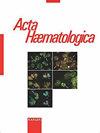综合营养干预对接受造血干细胞移植的血液病患者的益处。
IF 1.1
4区 医学
Q3 HEMATOLOGY
引用次数: 0
摘要
简介接受造血干细胞移植(HSCT)患者的营养状况至关重要。本研究旨在评估综合营养干预对接受造血干细胞移植的血液病患者健康状况的影响。方法共纳入 175 名接受造血干细胞移植的血液病患者,其中对照组 94 人,研究组 81 人。对照组患者接受标准护理,研究组患者接受综合营养干预。采用迷你营养评估(MNA)和主观全面评估(SGA)以及身体测量和血清中白蛋白、前白蛋白和血红蛋白水平对营养状况进行评估。但在出院时和出院后 3 个月,根据 MNA 和 SGA 评估,研究组营养不良的患者少于对照组。入院时,研究组与对照组在白蛋白、前白蛋白、血红蛋白水平、体重、小腿围(CC)、肱三头肌皮褶厚度(TSF)或肩胛下皮褶厚度(SSF)方面没有明显差异。然而,与入院时相比,出院时和出院后 3 个月,这些指标的水平明显下降。研究组的白蛋白、前白蛋白和血红蛋白水平以及体重、CC、TSF 和 SSF 在出院时和出院后 3 个月都明显高于对照组。本文章由计算机程序翻译,如有差异,请以英文原文为准。
Beneficial effect of integrated nutritional interventions in patients with hematological diseases undergoing hematopoietic stem cell transplant.
INTRODUCTION
The nutritional status of patients undergoing hematopoietic stem cell transplantation (HSCT) is critically important. This study was aimed to assess the impact of comprehensive nutritional interventions on the well-being of individuals with hematological diseases who underwent HSCT.
METHODS
A total of 175 patients with hematological diseases who underwent HSCT were included, with 94 in the control group and 81 in the research group. Patients in the control group received standard nursing care, while those in the research group underwent integrated nutritional interventions. Nutritional status was evaluated using the mini nutritional assessment (MNA) and subjective global assessment (SGA), along with body measurements and serum levels of albumin, prealbumin, and hemoglobin.
RESULTS
There were no significant differences in the proportion of malnourished patients evaluated by MNA or SGA between the control and research groups at admission. However, at discharge and 3 months post-discharge, fewer patients in the research group were malnourished compared to the control group, as assessed by both MNA and SGA. At admission, there were no significant differences in albumin, prealbumin, hemoglobin levels, weight, calf circumference (CC), triceps skinfold thickness (TSF), or subscapular skinfold thickness (SSF) between groups. However, at discharge and 3 months post-discharge, the levels of these indicators significantly decreased compared to those upon admission. Levels of albumin, prealbumin, and hemoglobin, as well as weight, CC, TSF, and SSF, were significantly higher in the research group than in the control group at both discharge and 3 months post-discharge.
CONCLUSION
HSCT led to a decline in nutritional status among patients with hematological diseases, but integrated nutritional interventions effectively improved their nutritional status.
求助全文
通过发布文献求助,成功后即可免费获取论文全文。
去求助
来源期刊

Acta Haematologica
医学-血液学
CiteScore
4.90
自引率
0.00%
发文量
61
审稿时长
6-12 weeks
期刊介绍:
''Acta Haematologica'' is a well-established and internationally recognized clinically-oriented journal featuring balanced, wide-ranging coverage of current hematology research. A wealth of information on such problems as anemia, leukemia, lymphoma, multiple myeloma, hereditary disorders, blood coagulation, growth factors, hematopoiesis and differentiation is contained in first-rate basic and clinical papers some of which are accompanied by editorial comments by eminent experts. These are supplemented by short state-of-the-art communications, reviews and correspondence as well as occasional special issues devoted to ‘hot topics’ in hematology. These will keep the practicing hematologist well informed of the new developments in the field.
 求助内容:
求助内容: 应助结果提醒方式:
应助结果提醒方式:


